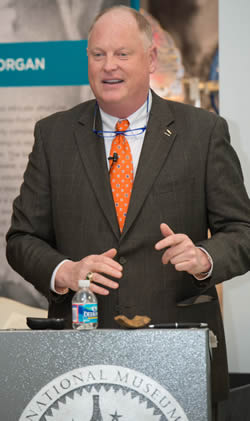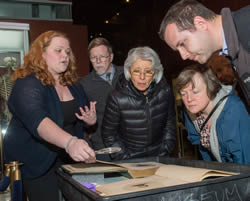Medical Museum's Science Café Unravels Mystery of Civil War Identity Theft
By Daniel Daglis
National Museum of Health and Medicine
On the evening of Feb. 22, 2016, U.S. Army Major William Hartel, who served two tours in the Middle East and one in Afghanistan and is an assistant professor of dentistry at the University of Tennessee, presented his findings on a suspected case of pension fraud during the Civil War to a crowd gathered for the February Medical Museum Science Café at the National Museum of Health and Medicine (NMHM).
"I was in Iraq preparing a lecture on military dentistry for the University of Tennessee," Hartel recalled. "I came across a journal article that featured Private Roland Ward and his infamous facial injury – very well known by military dentists. The next page has a photo of Private William Coder. Something didn't look right with the Coder description. It was suspicious that it said William Coder recovered with no treatment. Not many people could survive an injury like this, let alone recover. I've seen injuries like that during my tours - nobody just recovers."
Ward's injury happened when a shell fragment carried away the lower portion of his jaw within one inch of the ramus – the part of the jaw bone near the ear. Only two molar teeth on the right side and three on the left remained. The injury was sustained during the Battle of Weldon Rail Road in Virginia, on Aug. 25, 1864. During the course of his research, Hartel found no evidence that suggests Coder was even in the hospital.
Hartel shared photographs of similar facial injuries sustained during the Iraq War to further demonstrate the severity of this type of injury and just how much surgery is required to repair maxillofacial injuries. This, he said, is another example that makes Coder's recovery that much more impossible; especially without multiple visits to a hospital.
"There's not much known about William Coder because there were at least six [William Coders] that fought in the Civil War from Pennsylvania alone," said Hartel.
While in Iraq, Hartel's research led to long-distance e-mail communication with Laura Cutter, the museum's assistant archivist. Cutter provided supporting photos of the two cases from the museum's Otis Historical Archives. In July 2015, he visited the museum to view several publications relative to the case – the two most important being both volumes of Photographs of Surgical Cases from the Civil War and The Medical and Surgical History of the War of the Rebellion. The latter is a chronological catalogue that carefully documents injuries sustained by thousands of soldiers during the Civil War.
"In more than 6,000 pages of the Medical and Surgical History of the War of Rebellion, there was no mention of Coder," Hartel said. This further justified his suspicions of pension fraud.
The government's Bureau of Pensions had nearly closed before the Civil War, but once the Civil War began, the number of pensions grew dramatically. In 1861, there were roughly one million pensions, and several years after the war in 1890, there were 100 million. In 1865, the success rate on applying for a pension was at an all-time high of 90 percent; coincidentally this is the same year Coder filed for his pension.
Hartel's research suggests that the case of William Coder is an example of pension fraud. Comparing the photos and looking through NMHM collections, evidence suggests that the pictures of Coder's injuries were painted over, the equivalent of using Photoshop today to alter a photograph. Where Ward's case is carefully documented through multiple surgeries by famed facial surgeon Gurdon Buck, Coder is remembered with only one photograph in the Photographs of Surgical Cases from the Civil War and The Medical.
This case study both unveils the possibility of intentional deception using medical records during the Civil War, as well as highlights Hartel's contemporary military medicine expertise with maxillofacial injuries. Plastic surgery operations were uncommon during the Civil War and Roland Ward's two surgeries were well-known. He was able to somewhat recover and lead a fairly normal life, despite his devastating facial injury.
During World War I, facial injuries were common due to trench warfare, as soldiers were struck by gunfire and shrapnel when going "over the top" of a trench during an attack. In contemporary time, facial injuries are still an issue for service members returning from Iraq or Afghanistan. Advanced developments in the area of burn care, wound management and, eventually, face transplants, are helping restore form and function to wounded warriors.
NMHM's Medical Museum Science Cafés are a regular series of informal talks that connect the mission of the Department of Defense museum with the public. NMHM was founded as the Army Medical Museum in 1862 and moved to its current location in Silver Spring, Maryland, in 2012. NMHM is an element of the Defense Health Agency. For more information on upcoming events, please call 301-319-3303 or visit www.medicalmuseum.mil.

|
Caption:
U.S. Army MAJ William Hartel speaks about a possible case of Civil War-era pension fraud and his research using the Otis Historical Archives at the February Medical Museum Science Café, held Feb. 22, 2016, at the National Museum of Health and Medicine, in Silver Spring, Maryland. On the podium (beside the water bottle) is a fragment of a Civil War cannon ball. (National Museum of Health and Medicine photo by Matthew Breitbart / Released) |

|
Caption:
Laura Cutter (left), assistant archivist, Otis Historical Archives, National Museum of Health and Medicine, in Silver Spring, Maryland, shows attendees of the Feb. 22, 2016, Medical Museum Science Café photographs of Privates Roland Ward and William Coder from the museum's archives. (National Museum of Health and Medicine photo by Matthew Breitbart / Released) |



